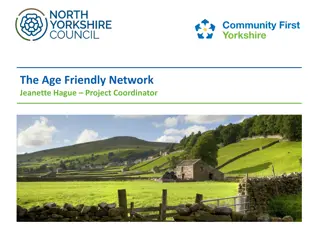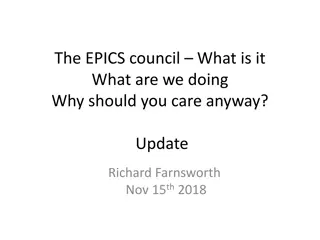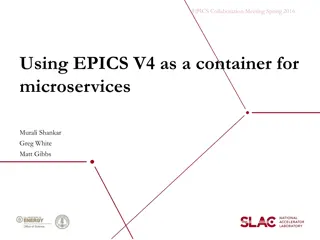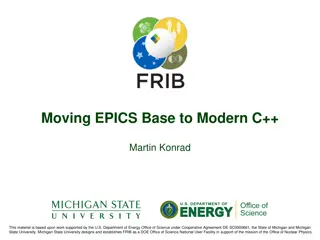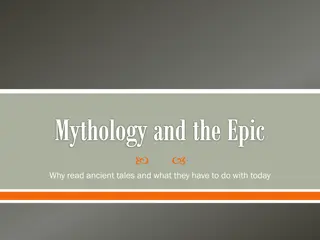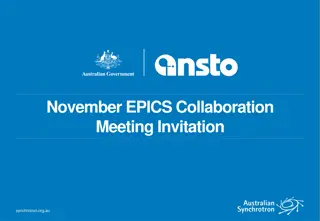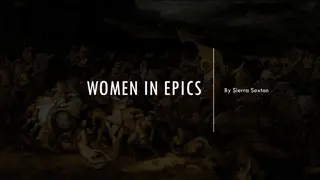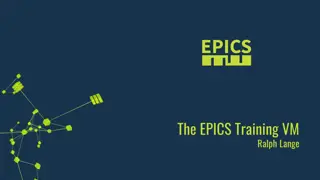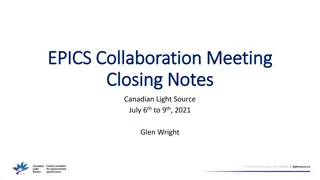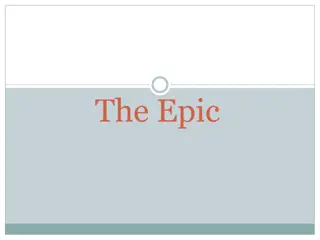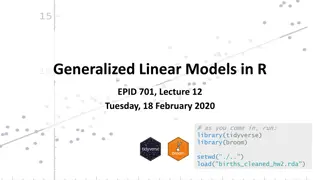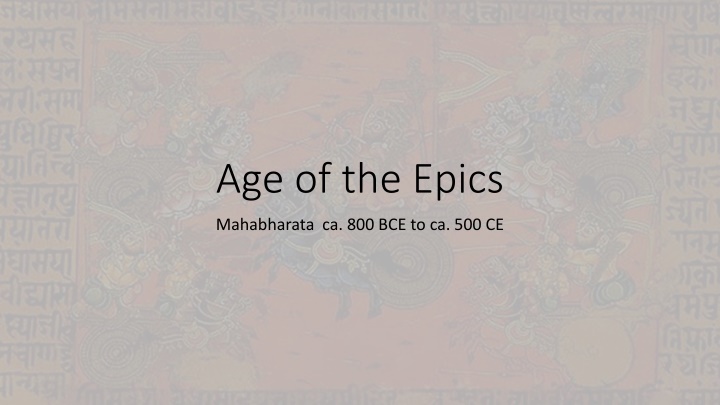
Exploring Mahabharata: A Source for Understanding History
Discover the Mahabharata epic, spanning from 800 BCE to 500 CE, and uncover its significance as a historical source. Dive into the plot, use of Mahabharata for history, its role as an epic of colonization, contradictions, and more.
Download Presentation

Please find below an Image/Link to download the presentation.
The content on the website is provided AS IS for your information and personal use only. It may not be sold, licensed, or shared on other websites without obtaining consent from the author. If you encounter any issues during the download, it is possible that the publisher has removed the file from their server.
You are allowed to download the files provided on this website for personal or commercial use, subject to the condition that they are used lawfully. All files are the property of their respective owners.
The content on the website is provided AS IS for your information and personal use only. It may not be sold, licensed, or shared on other websites without obtaining consent from the author.
E N D
Presentation Transcript
Age of the Epics Mahabharata ca. 800 BCE to ca. 500 CE
Main Focus of our Class Mahabharata (MBH) as a source for understanding HISTORY As a product of and representative of History We pay attention to literary merits, but that the story, the characters, etc. are not our major focus except when they illustrate important historical themes
Outline 1. What is an Epic 2. Outline of MBH plot 3. HOW do we use MBH as SOURCE for HISTORY 4. MBH as EPIC of COLONIZATION : conquest AND assimilation 5. Contradictions and how they help us understand the epic and history
MBH and Epics Two major Epics of India: the RAMAYANA and the MAHABHARATA Like all epics, MBH relates a heroic battle between good and evil Like all epics, MBH part of a long standing ORAL tradition. EPICs by nature are told and re-told Unlike Vedas, that are regarded as fixed (sruti), MBH part of a body of texts that allows for a more flexible retelling from memory (smriti) The MBH and Ramayana not written down till around 5thor 6thC CE. So what we have a variety of stories, with interpolations over time. Creates complications when using as text to understand History!
Plot outline STORY of two sets of cousins, the PANDAVAS and KAURAVAS. Their battle, main part of the story Like all epics, there are a lot of intersections between heaven and earth, between humans and Gods Cousins descended from two brothers, PANDU and DHRITARASHTRA. Kauravas trick Pandavas out of share of kingdom, via a game of dice (gambling) Lose the game and, have to spend 12 years in exile and 1 in disguise Pandavas go to exile, but Kauravas refuse to honor terms of the bet Leads to the battle, the Mahabharata, that Pandavas, with the help of ally, KRISHNA, able to win. This war is the central part of the story Lots of subplots, and some philosophy, particularly through the BHAGWAT GITA, a section which probably incorporated later into the text
MBH as a Historical Source Problems with dating an oral epic How? Creative use of historical imagination Interpretation of the text in light of what we DO know Little archeological evidence we do have available Earlier thought to be completely fanciful, but now believe the MBH is a MULTILAYERED AND CONTRADICTORY text, probably containing stories and interpolations from many times But which times? When is the core story? What evidence do we have for later interpolations
Tentative arguments for dating MBH It is a text of the VEDIC people, whose core story relates to the transition from early to later Vedic age, or thereabouts WHY? Kingdoms organized TERRITORIALLY, reference to the ASHWAMEDHA (horse sacrifice), ruling over territory etc. These are the NORMAL modes of organization So not nomadic. Disdain for forest dwellers (see EKLAVYA story) supports that. Also supported by: Archeological evidence Geographical location of core story There are anomalies, e.g. Varna divisions much more established than evident in Rig Veda But we can date the CORE of the story to around 1000-800 BCE and always keep in mind that parts were added later
MBH and Archeology ARCHEOLOGICAL excavations reveal places named and located in the epics with some evidence of settlement around 1000-800 BCE and later These are mostly sites connected with PAINTED GREY WARE, dated around 800-400 BCE, so there WERE settlements which are described in the MBH However these were not grand cities like the Pandavas Indraprastha, evidence suggests small mud and wattle dwellings, no bricks, no evidence of the fantastic palace the Pandavas built Perhaps simply exaggerations, but also likely later additions to the story Story says around 5 million people die in 18 day war, that indicates a total population of about 200 million, India s population did not reach such numbers till 18th or 19th centuries
MBH Geography and History LOCATION of the Story is Critical LOCATION of the Story is Critical LOCATION of places mentioned mainly in the north, Indo Gangetic Plain HASTINAPUR is 57 miles north of Delhi and INDRAPRASTHA present- day Delhi At the time of the core story, THE CENTRE of power of the Vedic people not moved further east as it did in the next few hundred years Although some locations further east and south mentioned, they are not central to the story Center of the RAMAYANA story further east
Studying the Source In reading ANY historical source, first we have to be aware of who is presenting that source, whose point of view (POV) it represents MBH clearly the POV of Vedic people, and even more so of the BRAHMINS or priests, who are TELLING the story At various points, Brahmins have obviously GLOSSED the story in a way favorable to themselves There are, as we will see, clear indications also of LATER interpolations by Brahmins BUT, although Brahmins tell the story, the story as we know it does have some element of what really happened (itihas, the Sanskrit word for History) too
Text and Context By ca. 700 BCE, the time estimated to be the original story of MBH, Vedic people given up pastoral nomadism, in favor of more settled life Led to territorial states, evident in the central plot of the MBH, that is a fight over territory Text mentions numbers of villages, and Duryodhana saying not even point of a needle of land would he give to his cousins We can locate most places mentioned as existing between c. 700 and 400 Kauravas and Pandavas belong to the tribe of the KURUS, Gandhari, mother of Kauravas from GANDHARA, Draupadi from PANCHALA, as also, MATSYA where the Pandavas spent last year of exile and ANGA, whose King Duryodhana made KARNA. Also mentioned KASHI, AVANTI, MAGADHA (Jarasandha, whom Bhima defeats) etc. So this is the geographical terrain. Map does not help us comprehend the much more DYNAMIC situation being described in the MBH... not the product of a single moment, but a period, and some of that pre-dates our map MBH describes a period when these territorial states still being set up, when boundaries still not fixed, when the eastward movements still happening, when the Vedic People still IN THE PROCESS of establishing their hegemony over the Gangetic plain
READING the MBH as Epic of Colonization Important to keep in mind that this is a READING of the text, against the grain. It is certainly not WRITTEN that way by the authors! Why Colonization? Because the eastward expansion into Gangetic plain did not occur over an EMPTY frontier People, Dasa and forest dwellers, living in areas into which Vedic influence expanded If we care to read it in that fashion, MBH can reveal to us something about the nature of the interaction between Vedic and non-Vedic people What is colonization? The action or process of settling among and establishing control over the indigenous people of an area Two parts to this, CONQUEST and ASSIMILATION, we will look at both
Colonization as Conquest and Assimilation Brahmins (priests) PIONEERS in the eastward movement. Vedas and Upanishads depict them in forests performing their SACRIFICES, with fire Brahmin colonizers, therefore consume large amount of forest for sacrifices Provokes forest dwellers to come out and attack them Who get termed RAKSHASAS, demons, represented as NON HUMAN (see HIDIMBAA, p. 31-33) RAKSHASA derive from word RAKSHA (to protect), thus the demon-ized ones may only be trying to protect their own resource base Brahmins then call on specialist warriors: Kshatriyas to help out, thus we have battle between Kshatriyas and Rakshasas that recurs in this epic and the Ramayana Disdain for forest dwellers also apparent in EKLAVYA story (see video) Colonization is not ONLY conquest and destruction, s also assimilation Bhima MARRIES a RAKSHASA, HIDIMBAA... suggesting they are not non-human after all!!
Contradictions and MBH as Process MBH is not just a story of conquest, or victory, careful reading reveals contradictions Contradictions or lacunae (gaps, missing stuff) reveals a bit of the on- going process that created the text we have today There are many, but for our purposes will focus on TWO of them ONE, Caste or VARNA TWO, GENDER or depictions of relations between men and women in the MBH
VARNA contradictions, relations between Brahmins and Kshatriya Lots of examples suggesting a FIXITY of Varna status and the clearly superior status of Brahmins within the varna hierarchy E.g. p 59 Duty of Kshatriya to look after Brahmins when leaving for forest Yudhishtira gambles away all land, except that given to Brahmins (p. 51) Yet, other examples point to something different Karna, regardless of known-varna status, can be made King (p. 26) Parasurama legend (p. 14) Drona a Brahmin, is not just a teacher, but a warrior. Bhima berates for not following the roles of his varna (p. 158) So what do these contradictions tell us?
Historical context, production over time Move to settled life, agriculture, kingship in transition period from early to later Vedic period does increase power of Brahmins Kings dependent on their authority to legitimize position But, as the Parasurama legend suggests, a great deal of tension between Brahmin and Kshatriya Much of the unquestioned respect for and superiority of, Brahmins probably a LATER INTERPOLATION into the story MBH text not written up until ca. 500 CE, that is a period of Brahminical reaction after a history (ca. 400 BCE to 300 CE) that had marginalized Brahmins and their ideologies MBH an attempt to GLOSS the story to emphasize their own ideology BUT, because people KNEW the story, from oral traditions, could not completely RE WRITE it, but give it a GLOSS
GENDER roles in the MBH This process of glossing most evident when looking at gender roles Strong women figures: KUNTI, DRAUPADI, GANDHARI, AMBA Yet a NARRATIVE framework that is evidently PATRIARCHAL A system in which men hold the power and women are largely excluded... CORE story, ca 800 BCE, state formation in place but not firmly established, varna society in place, but not firmly established, similarly gender relations not fully established Gender (and Varna and State) relations ARE established by ca. 300 CE (as we will see) giving predominance to men, Brahmins and kingship Thus, INTERPOLATIONS because orally known, cannot CHANGE it completely, but can insinuate narrative structure, as was done to MBH
Text and Context, again Women not as subordinate in pre-Vedic society, and quite possible that gender roles different in EARLY Vedic era too Seals and figures from the Indus Valley show women in roles that are not prescribed for women in later Vedic texts What we see in MBH therefore, are COMPETING and CONTRADICTORY elements, explained by the narrative structure Thus, Kunti exercises sexual choices, but with DIVINE beings Draupadi has five husbands, POLYANDRY, but only because her mother in law says so, accidentally Amba has her revenge, but as a MAN MBH reveals a social order in the MAKING Story of KRISHNA (dark skinned one) is another sort of example, but to which we will return later



